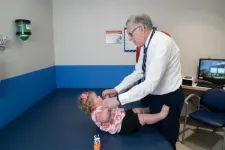(Press-News.org) Every minute, four males and six females need inpatient treatment due to suicide attempts around the world.
Males die from suicide at twice the rate of females, and their attempts result in death three times more often than female attempts.
Globally, 10% of suicides by males and 3% by females were with guns. In the U.S., 55% by males and 31% by females were with guns.
Between 1990 and 2021, the global age-standardized death rate for suicide declined by almost 40%, indicating that intervention and prevention are working.
Despite this progress, suicides increased 39% in Central Latin America, 13% in Andean Latin America, 9% in Tropical Latin America, and 7% in high-income North America.
SEATTLE, Wash., Feb. 19, 2025 – About 740,000 suicides are reported annually: that’s one death on average every 43 seconds, one of the many disturbing findings in the latest and most comprehensive analysis published today in The Lancet Public Health.
Researchers at the Institute for Health Metrics and Evaluation (IHME) at the University of Washington’s School of Medicine in Seattle conducted a deep dive of the Global Burden of Disease data by region, country, year, age, sex, and suicide by firearms from 1990 to 2021.
Over the last three decades, the global age-standardized mortality rate1 for suicide declined by nearly 40%, from about 15 deaths per 100,000 to 9 deaths per 100,000, indicating that intervention and prevention are working. For females, the rate declined by more than 50%, while it declined by almost 34% for males. Regionally, East Asia recorded the largest decline of 66% with China reporting the largest decline in the region.
While the progress is encouraging, it’s not universal. Four regions reported increases in the suicide rate1 for both sexes combined during the same period. Central Latin America had the highest jump at 39%, with Mexico at the top of the region’s list with a 123% increase for females alone. Andean Latin America had the second highest increase of 13%, with Ecuador recording the largest rise for both sexes combined in the region. Tropical Latin America was third with a 9% increase, and Paraguay was at the top of the region’s list for both sexes combined. High-income North America registered a 7% increase, with the U.S. at the top of the region’s list with a 23% jump for females alone.
Among the 2021 global causes of death, suicide was ranked 21st (higher than HIV/AIDS) for both sexes combined. Regionally, the highest mortality rates1 from suicide were in Eastern Europe, Southern sub-Saharan Africa, and Central sub-Saharan Africa. For males, suicide was the 19th-leading cause of death globally, with Eastern Europe recording the highest death rate. For females, suicide was ranked 27th globally, with South Asia having the highest rate for females.
“While the progress made in declining suicide rates is encouraging, it is clear that suicide continues to impact some countries and populations more than others. Removing suicide stigma and barriers to access mental health support systems remain critical measures, particularly among people with mental and substance abuse disorders,” said senior author Dr. Mohsen Naghavi with IHME.
Previous studies found that victims of violence, sexual assault, and childhood trauma are observed to be at increased risk for suicide. Research has consistently shown that access to lethal means, such as guns and pesticide, is associated with higher rates of suicides. Prior evidence suggests that poverty and social deprivation are also associated with suicide.
The latest numbers also underscore a grim difference between males and females globally, regionally, and nationally. Males were more than twice as likely to die from suicide than females, but females were 49% more likely to attempt it. According to researchers, every minute, four men and six women needed inpatient treatment due to suicide attempts. Overall, the mortality rate1 for suicide was 12.8 per 100,000 population for males and 5.4 per 100,000 population for females.
The incidence of suicide attempts requiring medical care that did not result in death was three times higher for females compared to males. This difference was highest in high-income North America, with one in 30.7 attempts resulting in death for females and one in 6.3 attempts resulting in death for males.
Globally, males were more than three times as likely to die by suicide using firearms than females: 10% of suicides by males were with guns, while 3% of suicides by females were with guns. The U.S. had the highest firearm-related suicides in the world: nearly 22,000 or 55% of suicides by males were with guns, while more than 3,000 or nearly 31% of suicides by females were with guns.
“Men tend to choose more violent and lethal methods of suicide such as guns, while women are more likely to choose less fatal means such as poisoning and overdosing, which have a higher survival rate,” said Emily Rosenblad, the study’s second author and project officer at IHME.
Both males and females globally are dying by suicide later in life. In 1990, the average age at death for males was 43 years, and for females it was almost 42 years. By 2021, the average age at death had climbed to 47 for males and nearly 47 for females. The highest mean age was about 58 years for males and 60 years for females, both in East Asia. Conversely, the youngest average age at suicide was found in Oceania, where it was 36 years for males and 34 years for females.
The study identifies the existing patterns and trends to develop more effective suicide prevention methods around the world, which can help policymakers and health care workers develop better-customized strategies and approaches for specific locations and populations.
Suicide prevention is most effective when communities work together through awareness, intervention, and support systems.
Notes to the Editor
1. Mortality rate is age-standardized.
END
About 740,000 global deaths from suicide occur annually--that's one death every 43 seconds
2025-02-20
ELSE PRESS RELEASES FROM THIS DATE:
Experts strongly recommend against spine injections for chronic back pain
2025-02-20
Spine injections should not be given to adults with chronic back pain because they provide little or no pain relief compared with sham injections, say a panel of international experts in The BMJ today.
Their strong recommendations apply to procedures such as epidural steroid injections and nerve blocks for people living with chronic back pain (lasting at least 3 months) that is not associated with cancer, infection or inflammatory arthritis.
Their advice is based on the latest evidence and is part of The BMJ’s ‘Rapid ...
Racism in medicine - are things getting better?
2025-02-20
Five years on since The BMJ’s special issue on racism in medicine, and a global pandemic, the landscape is very different, but has racism in the NHS and UK medicine got better or worse?
In 2020, a BMJ investigation found that UK medical schools were failing to deal with complaints of racism. Another round of requests to the UK’s 46 medical schools has now found that eight in 10 (34 of 41 that responded) are collecting data on complaints about racism, up from half in 2020. And the number ...
Forcing UK creatives to ‘opt out’ of AI training risks stifling new talent
2025-02-20
The UK government should resist allowing AI companies to scrape all copyrighted works unless the holder has actively “opted out”, as it puts an unfair burden on up-and-coming creative talents who lack the skills and resources to meet legal requirements.
This is according to a new report from University of Cambridge experts in economics, policy and machine learning, who also argue the UK government should clearly state that only a human author can hold copyright – even when AI has been heavily involved.
A collaboration between three Cambridge initiatives – ...
Almost 90% of people would agree to genetic testing to tailor medication use, survey finds
2025-02-20
New research shows almost 90% of people in England would agree to genetic testing to get the most effective medication and reduce the risk of side effects
85% thought that the NHS should offer pharmacogenomic testing to people with multiple health conditions
58% of people thought that the NHS should offer this testing to everyone
91% wanted access to their own pharmacogenomic data, with many wanting this via the NHS app
Pharmacogenomics – an individual’s genetic response to medications – is an increasingly important strand of personalised healthcare but little is known about the public's views ...
Study: UTA research drives widespread economic impact
2025-02-19
University of Texas at Arlington research projects contributed $59 million to the national economy in 2024—an increase of 39% from 2023, according to a new report from the Institute for Research on Innovation and Science (IRIS).
UTA has invested heavily in research infrastructure, purchasing cutting-edge scientific equipment and technology, such as North Texas’ most advanced gene sequencer and a super-sensitive magnetic resonance imaging machine for the Clinical Imaging Research Center. The funds also support collaboration with other research organizations.
UTA worked through 1,144 unique ...
Promising results from first prenatal therapy for spinal muscular atrophy
2025-02-19
(MEMPHIS, Tenn. – February 19, 2025) Spinal muscular atrophy (SMA) is a progressive neurodegenerative disorder set in motion before birth. Scientists at St. Jude Children’s Research Hospital led the first in uterotreatment of SMA with the orally administered drug risdiplam. More than two years after the child was born, no identifiable features of SMA have been observed. This study demonstrates the feasibility of treating SMA prenatally and supports further investigation into the approach. The findings were published ...
Nitrogen fixation on marine particles is important in the global ocean
2025-02-19
How on Earth?
It has puzzled scientists for years whether and how bacteria, that live from dissolved organic matter in marine waters, can carry out N2 fixation. It was assumed that the high levels of oxygen combined with the low amount of dissolved organic matter in the marine water column would prevent the anaerobic and energy consuming N2 fixation.
Already in the 1980s it was suggested that aggregates, so-called “marine snow particles”, could possibly be suitable sites for N2fixation, ...
FDA approves vimseltinib for tenosynovial giant cell tumor (TGCT)
2025-02-19
The U.S. Food and Drug Administration (FDA) has approved vimseltinib (RomvimzaTM) for adult patients with a rare condition called tenosynovial giant cell tumor (TGCT). TGCT is a tumor of the tissue that lines the joints.
Sarcoma oncologist William Tap, MD, Chief of the Sarcoma Medical Oncology Service at Memorial Sloan Kettering Cancer Center (MSK), led the international phase 3 MOTION trial that resulted in the drug’s approval. Vimseltinib is a type of targeted therapy called a kinase inhibitor and is taken as a pill.
“This approval is an exciting advance for ...
Columbia Climate School launches M.S. in Climate Finance
2025-02-19
The Columbia Climate School has announced the first master’s degree program in the United States for climate finance. In close collaboration with the Columbia Business School, this interdisciplinary degree will drive impactful solutions to the climate crisis through advanced financial tools and scientific knowledge. This is the third master’s program announced by the Climate School, in addition to an M.A. in Climate and Society and an M.S. in Climate degree.
“The world needs problem-solvers to address the global climate crisis,” said Alexis Abramson, dean of the Columbia Climate School. “Everyone ...
MD Anderson receives nearly $23 million in CPRIT funding for cancer research, faculty recruitment
2025-02-19
HOUSTON ― The University of Texas MD Anderson Cancer Center today was awarded nearly $23 million from the Cancer Prevention and Research Institute of Texas (CPRIT) in support of 20 cancer research projects to advance new breakthroughs in discovery, translational, clinical and prevention science. In addition, CPRIT awarded $2 million for the recruitment of one first-time, tenure-track faculty member.
“We sincerely appreciate CPRIT’s continued funding of impactful cancer research that will help us achieve our mission to end cancer,” said ...


